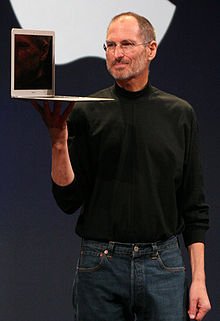Steve Jobs will always be known as the pioneering founder of Apple Computers that was an expert in anticipating consumer response to new technology. Some people referred to Jobs as a high-tech toymaker that knew how to market anything in a way that people would have to buy it. But Jobs helped to advance technology in a way that benefits important areas such as medicine, law enforcement and education.

To understand the importance and impact of Steve Jobs, we need to look at the timeline of his career. Jobs always said that he was defined by his accomplishments and he tried to make every day of his life count. He did not dwell on failure but preferred to move on to the next accomplishment. How Jobs went from a college dropout to one of the most influential business people in American history is a very interesting story.
1972
Steve Jobs enrolls at Reed College in Portland, OR. His family was unable to afford to keep him in school, so he dropped out after one semester. But rather than leave Reed, Jobs kept going to classes and slept on the floor of a friend’s house. He paid his way by recycling soda pop bottles and getting free meals from a local religious group.
1974
Jobs returned to his hometown of Cupertino, CA to team up with high school friend Steve Wozniak to attend group meetings for the Homebrew Computer Club. Jobs also got his first job in the technology industry when he got a position as a video game technician for Atari.
1976
Along with Steve Wozniak and Ronald Wayne, Steve Jobs borrowed money from former Intel marketing expert A.C. Markkula to start Apple Computers. When Jobs and Wozniak started Apple, Steve Jobs was only 21 years old. Wozniak had the engineering ability and Jobs was the salesman. Jobs never expressed an interest in understanding how to make the technology. He was more interested in what the technology could do.
1984
After several difficult years with former National Semiconductor CEO Mike Scott running Apple along with Jobs, Steve Jobs decided that the company needed a change. Jobs lured Pepsi Cola CEO John Sculley away from the soda giant to help run Apple. This was also the year that Jobs and Apple introduced the Macintosh computer using the controversial commercial titled “1984.” The commercial portrayed competitor IBM as being the character of “Big Brother” from the book “1984.” Apple was the way that consumers could break away from “Big Brother” and explore computers on their own. The commercial was very successful and the Macintosh went on to be a success.
1985
Jobs and Sculley cannot get along and Apple employees begin complaining about Jobs’ eccentric management style. Sculley fires Jobs from Apple. Immediately after being fired, Jobs started the NeXT Computer Company which saw moderate success.
1986
Steve Jobs buys the The Graphics Group because of his fascination with combining computers and cartoon animation. The Graphics Group would eventually go on to be renamed Pixar and strike a very lucrative partnership with the Walt Disney Corporation.
1993
NeXT Computers fails as a hardware manufacturer so it transitions to become a software developer.
1996
NeXT releases WebObjects, which would become the default platform for web application development. NeXT realizes its first profit in years and is bought by Apple. This brings Steve Jobs back into Apple as an executive. When CEO Gil Ameilo leaves Apple in July, Jobs takes on the role of interim CEO.
2000
Steve Jobs becomes the full-time CEO of Apple Computers which is a position he has never held before despite being a co-founder of the company in 1976. Jobs embarks on an ambitious development program that results in the creation of iTunes, the iPhone, the iPod and the iPad.
2004
Steve Jobs announces that he has pancreatic cancer and takes a leave of absence from Apple. After what was announced to be a successful surgery to remove a tumor later in the year, Jobs returns to Apple.
2006
Steve Jobs gives the keynote speech at the Apple Worldwide Developer’s Conference but looks thin and frail. Rumors begin to swirl about his health.
January 2011
After a liver transplant and other health problems, Steve Jobs takes a leave of absence from Apple to focus on recovery.
August 2011
Steve Jobs officially resigns as Apple CEO. Jobs said that the reason he resigned was because he could no longer perform his duties and he wanted to make sure a competent successor was put in place. The replacement is long-time Jobs’ associate Tim Cook.
October 5, 2011
Steve Jobs passes away.
This is a guest article from George Stanzan, who writes for GIQ.


